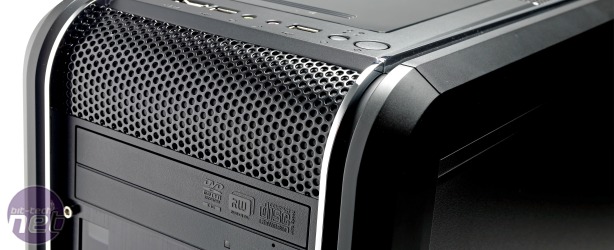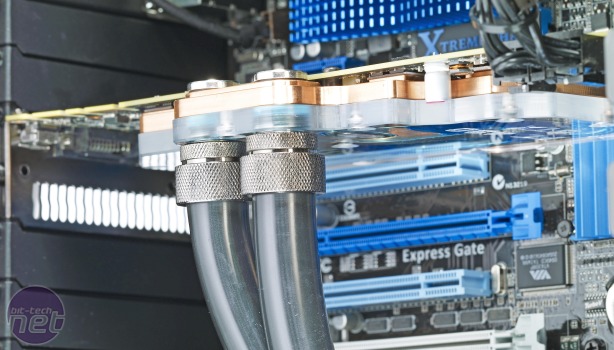More Specs and Features
The Cyclone also sports a similarly impressive CPU. Scan has opted to use the 2.66GHz Core i7-920, which is nearing the end of its lifespan now that its replacement, the 2.8GHz Core i7-930, has been released. However, Scan has heavily overclocked the CPU to the extent that you’d never notice the difference. The Asus P6X58D-E motherboard has allowed the CPU multiplier to be knocked up a notch from 20 to 21, the same as that of the i7-930, and the QPI of 191MHz has resulted in a frequency identical to that of the 4GHz i7-930 Gladiator Titan Prometheus.To accomplish the CPU overclock, Scan has set the CPU’s vcore to 1.35V, the CPU PLL to 1.8V, the IOH (Southbridge) voltage to 1.14V and set the QPI frequency to 6,893MHz. Rather than use a low-cost liquid cooler such as the Corsair H50 of the Prometheus, Scan uses a high-end air cooler in the shape of the Prolimatech Megahalems.
This is a large tower heatsink that comprises two separate towers of cooling fins supported by six 6mm, nickel-plated copper heatpipes, to which Scan has added another 120mm Akasa Black Apache fan, as the Megahalems ships without a fan.
The Asus motherboard allows the i7-920 to convincingly mimic the performance of the newer i7-930 and is a decent basis for a high-performance system. However, we prefer the Gigabyte GA-X58A-UD3R, as it’s cheaper and has more features. However, the Asus board provides SATA 6Gbps and USB 3 support – even if the former is a touch sluggish – and it’s a capable overclocker with great cooling.
Sitting snugly in the motherboard is 6GB of Corsair XMS3 1,600MHz DDR3 memory, split across three 2GB sticks. The high 191MHz QPI means that the memory strap has to be set to 8, resulting in a memory speed of 1,528MHz. Setting the memory strap to 10, the next setting up, would mean a memory speed of 1,910MHz, which is way beyond this memory’s capabilities.
Scan has kept matters relatively simple when it comes to storage in the Cyclone, with a single 1TB Western Digital Caviar Black 7,200rpm hard disk. The disk supports SATA 6Gbps, although this is just a meaningless gimmick, as hard disks don’t come near to saturating a SATA 3Gbps connection let alone a connection that has twice that bandwidth.
Still, the Caviar Black’s pair of 500GB platters means that it performs fairly closely to the faster, cheaper Samsung SpinPoint F3 that we prefer. Considering the £1,640 price tag of this system, we’re surprised not to find an SSD; even a top-end 64GB drive makes a great boot or games drive, and only costs £150 or so. We were also disappointed that the Cyclone doesn’t include a sound card, so you’ll have to rely on the on-board Realtek audio codec.
Power duties are handled by a Corsair HX650 modular 650W PSU, a surprisingly low-wattage choice, considering that similarly speedy systems tend to ship with 850W or even 1kW power supplies. We found that the system used around 550W under full graphics and CPU load, with no sign of instability. However, while the 650W Corsair PSU is clearly fine for powering this PC today, there isn’t much headroom for significant future upgrades.
Playing host to this array of tantalising tech is the Cooler Master CM 690 II Advanced chassis, which is a popular choice with system builders, thanks to its flexible cooling setup and compact size. As well as the water-cooling loop fitted into the case’s pair of roof 120mm fan mounts, there’s also a blue LED-illuminated 140mm intake fan at the front of the case and a 120mm exhaust fan fitted to the rear.
Scan has attached a plate to the front of the bay reservoir to add a touch of brushed aluminium chic, and installed an Akasa card reader in the 2.5in external bay.

MSI MPG Velox 100R Chassis Review
October 14 2021 | 15:04











Want to comment? Please log in.